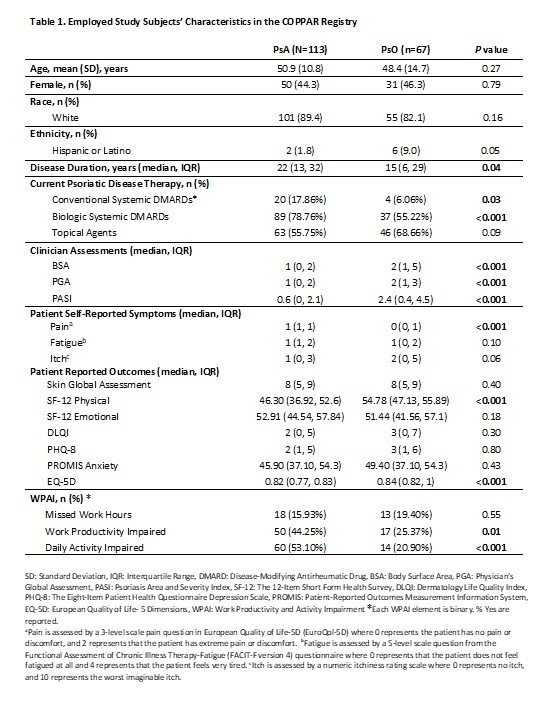Session Information
Session Type: Poster Session A
Session Time: 9:00AM-11:00AM
Background/Purpose: Patients with Psoriatic Arthritis (PsA) and Psoriasis (PsO) have an increased rate of work loss due to their disease compared the general population; however, little is known about the impact of their illness on work productivity among those who remain employed. Our goal was to evaluate the differential effect of self-reported disease symptoms and severity on the ability to work.
Methods: Data from study subjects who participated in the Cohort of Psoriasis and Psoriatic Arthritis Registry (COPPAR), a prospective, longitudinal registry of adult subjects with PsA or PsO at a large academic medical center, were analyzed. Demographics and disease characteristics of the study subjects were summarized by diagnosis (PsA vs. PsO) and compared using univariate statistics. Work Productivity and Activity Impairment (WPAI) survey data were collected at baseline and assessed in three binary domains: missed work, impaired work productivity, and impaired daily activity due to their illness. All subjects had disease severity measured by the Psoriasis Area and Severity Index (PASI), and self-reported disease symptoms were assessed as the amount of overall pain, degree of skin itch, and fatigue measured on a rating scale. Symptoms and disease severity variables, along with demographics, were tested in logistic regression models to determine their associations with WPAI outcomes.
Results: Of 288 cohort subjects who completed the WPAI survey, 180 (63%) subjects were currently employed (113 PsA and 67 PsO subjects). Study subjects had a mean age of 49.7 years, 45.3% female, and 85.8% White (Table 1). The mean disease duration was 22 years for PsA and 15 years for PsO (p=0.04). PsO subjects had more severe skin disease, while PsA subjects were more likely to be on biologic therapies (Table 1). In univariate analyses, there were no statistically significant differences in missed work between PsA and PsO subjects (15.93% vs. 19.40%, p=0.55), but PsA subjects reported more impaired work productivity (44.25% vs. 25.37%, p=0.01) and impaired daily activities outside of work hours (53.10% vs. 20.9%, p< 0.001). However, the adjusted regression model showed that study subjects who had missed work reported more fatigue ([Odds Ratio (OR)]:2.17, p< 0.001). Study subjects who had impairment in work productivity reported more pain (OR:6.94, p< 0.001), fatigue (OR:2.39, p< 0.001), and itch (OR:1.3, p=0.01). Study subjects who reported daily activity impairment outside of work hours reported more fatigue (OR:2.16, p< 0.001), pain (OR:5.6, p< 0.001) and were more likely to have PsA than PsO (OR: 3.73 p=0.01). Of note, the PASI score was not associated with any of the three WPAI impairment domains.
Conclusion: While employed individuals with PsA reported more impaired work productivity than those employed who had PsO, impairment was driven by pain, itch, and fatigue rather than arthritis diagnosis and skin disease severity. Eliciting these symptoms may help rheumatologists better tailor interventions to improve an individual’s capacity to work.
To cite this abstract in AMA style:
Shadick N, Schnock K, Feather V, Li R, Cui J, Patel S, Goutier S, Yussuff M, Perez-Chada L, Weinblatt M, Merola J. Factors Associated with Work Productivity Among Individuals with Psoriatic Arthritis (PsA) and Psoriasis (PsO): The Role of Patient Reported Outcomes and Disease Severity [abstract]. Arthritis Rheumatol. 2023; 75 (suppl 9). https://acrabstracts.org/abstract/factors-associated-with-work-productivity-among-individuals-with-psoriatic-arthritis-psa-and-psoriasis-pso-the-role-of-patient-reported-outcomes-and-disease-severity/. Accessed .« Back to ACR Convergence 2023
ACR Meeting Abstracts - https://acrabstracts.org/abstract/factors-associated-with-work-productivity-among-individuals-with-psoriatic-arthritis-psa-and-psoriasis-pso-the-role-of-patient-reported-outcomes-and-disease-severity/


